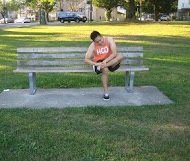Overview
If you know somebody who has had a sprain, or if you have had a sprain before, there are several steps to keep in mind in regards to first aid and emergency treatment:

- Ensure you and the victim are safe – if you are not the victim. This means that you should also have on protective equipment if available to avoid contaminating yourself with any illnesses the victim may have.
- A sprain is not necessarily something where an ambulance has to be called for. In fact, it is recommended to simply see a doctor if the sprain:
- Is very painful
- The victim cannot put their weight onto the area
- The joint looks different, other than swelling
- The victim cannot move
- The victim cannot walk more than four steps with the injury
- Numbness is present
- There are red streaks of blood coming from the injured area
- It has been sprained or broken before
- To treat the sprain, use the RICE method:
- R: rest the sprained area and do not put weight on it, you can use a crutch or cane to get around in the meantime if needed.
- I: ice the area with an ice pack.
- C: compress the sprain with an elastic bandage.
- E: elevate the sprain above the heart to help with swelling during the first 48 hours after this happens.
Overview of a Sprain
The most common areas for a sprain is in the ankle, wrist and knee. However, these sprains can occur in any part of the body. A sprain is defined as a tear or stretch in the ligament that is connecting the bones.
Causes of Sprains
The causes of sprains are:
- Accidents or trauma to the body
- Lifting objects that are heavy
- Injuries due to playing sports
Symptoms of a Sprain
The symptoms of a sprain include:
- Swelling
- Pain
- Lumps around the area
- Redness or bruising around the area
- Numbness
- Inability to manipulate the joint
Treating
If you need to treat a sprain at home, remember to:
- Apply ice packs every 20 minutes, 4 to 8 times per day. Ensure the ice is wrapped in a towel to avoid damage to the skin
- Use compression bandages to keep the swelling down
- Keep the injury elevated if possible
- Take anti-inflammatory medications for pain
- Rest
You should consult a doctor in the event that you cannot move the joint or the pain does not subside. Be sure that you do not return to your normal activities until the sprain has healed, you should also excuse, warm up before excercising, and take care once returning to normal activities to avoid spraining the muscle again.
Related Video On Sprains
https://www.youtube.com/watch?v=BZMD3cfyjVI
